Dysrhythmia and pacemaker - Study guides, Class notes & Summaries
Looking for the best study guides, study notes and summaries about Dysrhythmia and pacemaker? On this page you'll find 1252 study documents about Dysrhythmia and pacemaker.
Page 3 out of 1.252 results
Sort by

-
Basic Dysrhythmia Questions & Answers; All Correct & Verified
- Exam (elaborations) • 15 pages • 2023
-
- $7.99
- + learn more
Basic Dysrhythmia Questions & Answers - Ventricular paced rhythm, Atrial paced rhythm, Failure to sense (pacemaker), Failure to capture (pacemaker), Asystole, Accelerated Idioventricular Rhythm, Idioventricular Rhythm, Ventricular fibrillation (V-fib), Torsades de pointes, monomorphic ventricular tachycardia, PVC couplets, Bigeminy PVC, Premature ventricular contraction (PVC), 3rd degree heart block, 2nd Degree Heart Block (Mobitz II), 2nd degree heart block type 1 (Wenkebach), First degree hear...
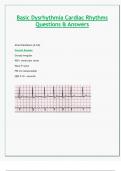
-
Basic Dysrhythmia Cardiac Rhythms Questions & Answers
- Exam (elaborations) • 20 pages • 2023
-
- $7.99
- + learn more
Basic Dysrhythmia Cardiac Rhythms Questions & Answers - Cardiac Rhythm Pictures - Atrial Fibrillation (A-Fib), Atrial Flutter, Paced Atrial, 1° AVB, 2° AVB Type I (Wenkebach), 2° AVB Type II (Mobitz), 2° AVB 2:1, 3° AV Block (Complete Heart Block), Bundle Branch Block (BBB), Sinus Rhythm, Sinus Bradycardia, Sinus Tachycardia, Sinus arrhythmia, Sinus Arrest/Exit block, Bigeminy, Trigeminy, Premature Atrial Contraction (PAC), Premature Junctional Contraction (PJC), Junctional Rhythm (Junction...
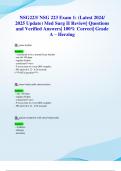
-
NSG223/ NSG 223 Exam 1: (Latest 2024/ 2025 Update) Med Surg II Review| Questions and Verified Answers| 100% Correct| Grade A – Herzing
- Exam (elaborations) • 20 pages • 2024
-
Available in package deal
-
- $10.99
- + learn more
NSG223/ NSG 223 Exam 1: (Latest 2024/ 2025 Update) Med Surg II Review| Questions and Verified Answers| 100% Correct| Grade A – Herzing Q: sinus rhythm - considered to be a normal heart rhythm - rate 60-100 bpm - regular rhythm - consistent P wave - P wave prior to every QRS complex - PR interval 0.12 - 0.20 seconds (***SATA question***) Q: sinus bradycardia characteristics Answer: - rate <60 bpm - regular rhythm - consistent P wave - P wave prior to every QRS complex...
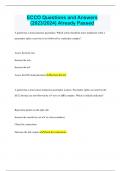
-
ECCO Questions and Answers (2023/2024) Already Passed
- Exam (elaborations) • 104 pages • 2023
- Available in package deal
-
- $12.49
- + learn more
ECCO Questions and Answers (2023/2024) Already Passed A patient has a transcutaneous pacemaker. Which action should the nurse implement when a pacemaker spike occurs but is not followed by ventricular complex? Assess the heart rate Increase the mA Increase the mV Assess the ECG lead placement Increase the mA A patient has a transvenous temporary pacemaker in place. Pacemaker spikes are noted on the ECG, but they are not followed by a P wave or QRS complex. Which is initially indicated? Rep...
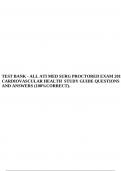
-
TEST BANK - ALL ATI MED SURG PROCTORED EXAM 2019 CARDIOVASCULAR HEALTH STUDY GUIDE QUESTIONS AND ANSWERS (100%CORRECT).
- Exam (elaborations) • 253 pages • 2024
-
- $17.99
- + learn more
TEST BANK - ALL ATI MED SURG PROCTORED EXAM 2019 CARDIOVASCULAR HEALTH STUDY GUIDE QUESTIONS AND ANSWERS (100%CORRECT). ATI MED SURG PROCTORED EXAM 2019 – CARDIO STUDY GUIDE A nurse is performing discharge teaching with a client who has an implantable cardioverter defibrillator (ICD) placed. Which client statement indicates effective teaching? Correct response: • "I'll keep a log of each time my ICD discharges." The nurse is caring for a client scheduled for a transesophageal echoca...
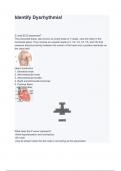
-
Identify Dysrhythmia! Exam Questions And Answers
- Exam (elaborations) • 16 pages • 2024
- Available in package deal
-
- $12.99
- + learn more
Identify Dysrhythmia! Exam Questions And Answers 2 Lead ECG placement? The precordial leads, also known as chest leads or V leads, view the heart in the horizontal plane. They include six unipolar leads (V1, V2, V3, V4, V5, and V6) that measure electrical activity between the center of the heart and a positive electrode on the chest wall. Heart conduction 1. Sinoatrial node 2. Atrioventricular node 3. Atrioventricular bundle 4. Right and left bundle branches 5. Purkinje fibers ...
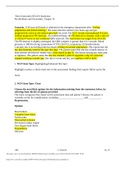
-
NURSING 430 Next Generation NCLEX Questions student Dysrhythmia and Pacemaker, Chapter 35
- Exam (elaborations) • 3 pages • 2023
-
- $8.49
- + learn more
Next Generation NCLEX Questions Dysrhythmia and Pacemaker, Chapter 35 Scenario: A 38-year-old female is admitted to the emergency department after “feeling palpitations and almost fainting.” She states that this started a few hours ago and got progressively worse as she tried to get ready for work. The ECG reveals nonconducted P waves without progressive PR intervals. On conducted beats, the PR interval is constant, with a ratio of 3:1 (three P waves to one conducted QRS interval). The...
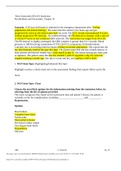
-
NURSING 430 Next Generation NCLEX Questions student Dysrhythmia and Pacemaker, Chapter 35
- Exam (elaborations) • 3 pages • 2023
-
- $8.49
- + learn more
Next Generation NCLEX Questions Dysrhythmia and Pacemaker, Chapter 35 Scenario: A 38-year-old female is admitted to the emergency department after “feeling palpitations and almost fainting.” She states that this started a few hours ago and got progressively worse as she tried to get ready for work. The ECG reveals nonconducted P waves without progressive PR intervals. On conducted beats, the PR interval is constant, with a ratio of 3:1 (three P waves to one conducted QRS interval). The...

-
Exam 1: Dysrhythmias (NCLEX)with answers 2024
- Exam (elaborations) • 17 pages • 2024
- Available in package deal
-
- $17.99
- + learn more
Exam 1: Dysrhythmias (NCLEX)A client's electrocardiogram strip shows atrial and ventricular rates of 80 complexes per minute. The PR interval is 0.14 second, and the QRS complex measures 0.08 second. The nurse interprets this rhythm is: A) Normal sinus rhythm B) Sinus bradycardia C) Sinus tachycardia D) Sinus dysrhythmia - correct answer A A client has frequent bursts of ventricular tachycardia on the cardiac monitor. A nurse is most concerned with this dysrhythmia because: A) It is...
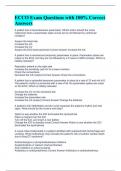
-
ECCO Exam Questions with 100% Correct Answers
- Exam (elaborations) • 41 pages • 2024
- Available in package deal
-
- $14.49
- + learn more
A patient has a transcutaneous pacemaker. Which action should the nurse implement when a pacemaker spike occurs but is not followed by ventricular complex? Assess the heart rate Increase the mA Increase the mV Assess the ECG lead placement Correct Answer Increase the mA A patient has a transvenous temporary pacemaker in place. Pacemaker spikes are noted on the ECG, but they are not followed by a P wave or QRS complex. Which is initially indicated? Reposition patient on the right side...

How did he do that? By selling his study resources on Stuvia. Try it yourself! Discover all about earning on Stuvia


